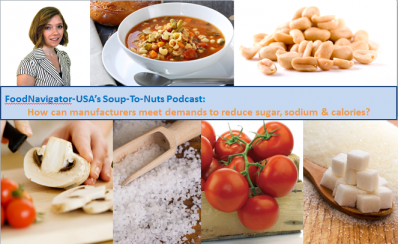IFT 2016 in review
Dairy Permeate cuts manufacturing costs and sodium while boosting nutrition, USDEC says
For many manufacturers the task of cutting sodium as dramatically as encouraged by FDA is a daunting task for fear that consumers will turn away from reformulated foods that do not have the same salty flavor to which they are accustomed. Not to mention the time and cost it takes to reformulate.
But the US Dairy Export Council sees the guidelines as an opportunity for manufacturers to meet consumer desire for better-for-you products and to even save money on raw materials.
“The sodium reduction guidelines that are voluntary that we have seen coming out are really an opportunity for the food and beverage industry,” especially if they take the full time allowed by FDA to slowly reduce sodium levels “so that it is not a big shock to consumers,” Kara McDonald, VP of global marketing communications for the US Dairy Export Council, told FoodNavigator-USA at IFT in Chicago.
“What we are finding that works best with consumers who might be afraid of seeing reduced sodium on the label because they might think it won’t taste as good” is for manufacturers to take a stealth health approach behind the scenes and replace sodium with other ingredients that maintain the salty flavor consumers want so “that the consumer doesn’t really realize it has been better formulated for them,” McDonald explained.
Dairy Permeate is an ideal ingredient for reducing sodium 50% to 70% in this way across platforms, including baked goods, soup and sauces, confections, dry mixes, meats and even beverages, she noted.
“Dairy Permeate comes from processing either milk protein concentrate or whey protein concentrate” and is a combination of lactose, ash and protein that “has this natural saltiness and umami flavor,” she explained, adding that “it also is a great sodium replacer” at levels of 10 grams of Permeate per one gram of salt.
At IFT, the US Dairy Export Council showcased the diverse uses of the ingredient in three prototypes, including a yogurt barley soup in which the council cut sodium 23% from about 530 grams to 410 mg without impacting the flavor. A protein-packed samosa and mango chutney cottage cheese dip made with Permeate also were on display.
Beyond sodium reduction
Permeate offers more than just sodium reduction – it also offers functional benefits, adds on-trend macro-nutrients to products and can help manufacturers trim production costs by replacing other more expensive ingredients, McDonald said.
For example, because Permeate is 76% to 85% lactose it helps with browning, absorbs volatile flavor compounds, attracts and absorbs synthetic and natural pigments and has a low affinity for moisture. It also is a crystallizable sugar that is less sweet than sucrose and can help with browning, according to the council’s marketing materials.
In addition, Permeate can help boost the nutritional profile of products, McDonald said. It has between 2% and 7% protein, which remains a high-demand ingredient for many consumers, and has a maximum of 14% ash, which contains calcium, phosphorus and other valuable minerals, according to the council.
Manufacturers can use Permeate without fear that it will turn off consumers seeking products with simple, recognizable ingredients, McDonald said.
Permeate “really fits with a clean label. It is often listed as dairy product solids, which is really recognizable and consumers really feel good about different dairy ingredients and they value the nutrition that they bring,” McDonald explained.
Finally, “Permeate can be a real bonus for a formulator because of the bulk that it adds in the sodium replacement, so that you can actually reduce some other levels of ingredients,” such as eggs, sugar, flour, fat and other carbohydrates, she said. As a result, she added, formulating with Permeate could help manufacturers “have an overall cost reduction in the formulation.”




















